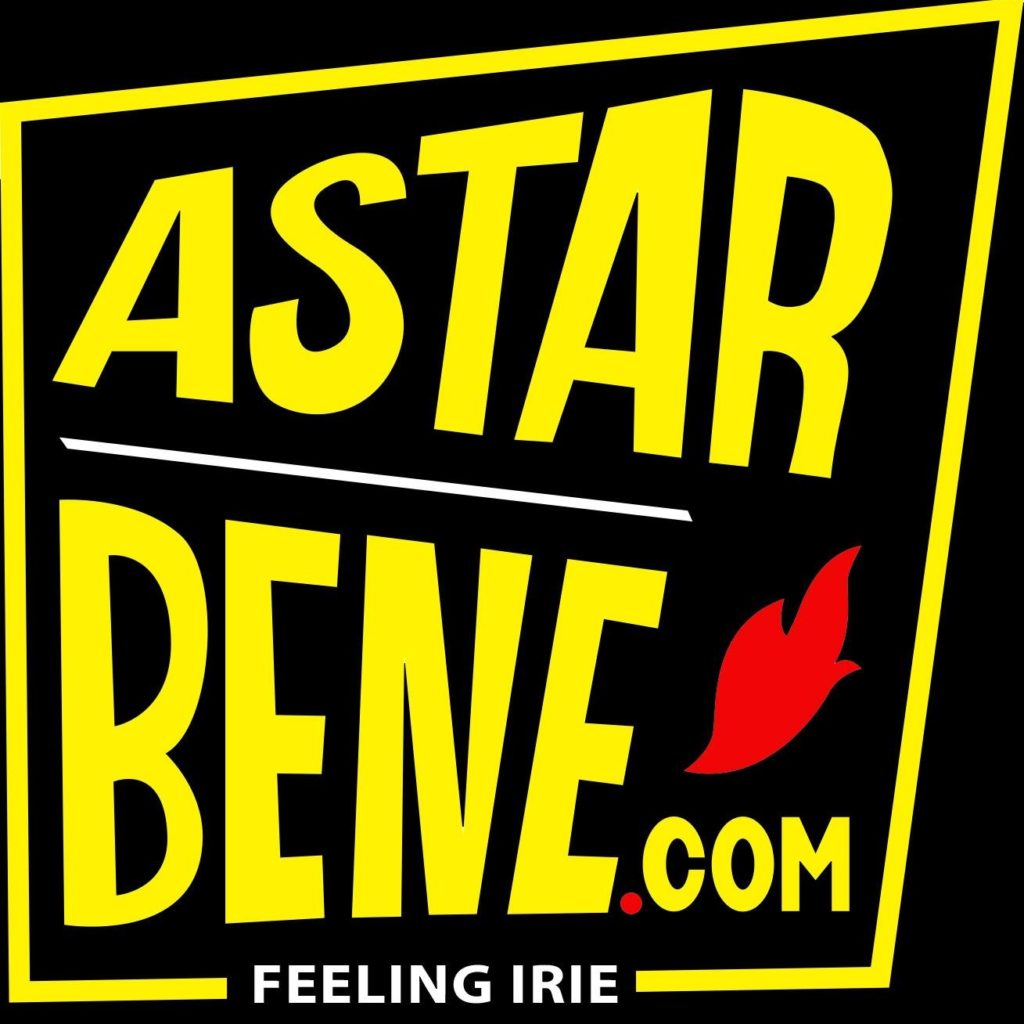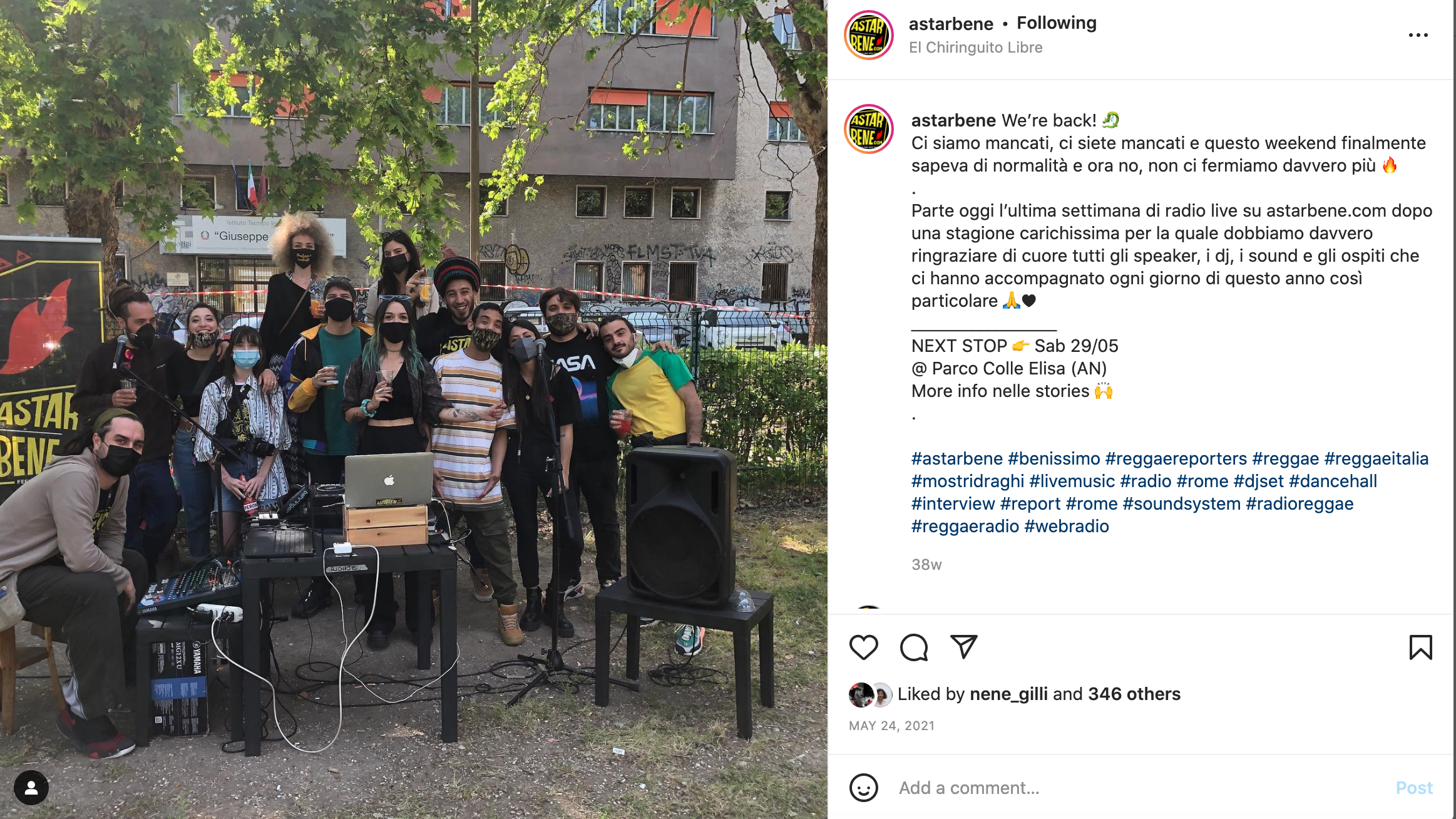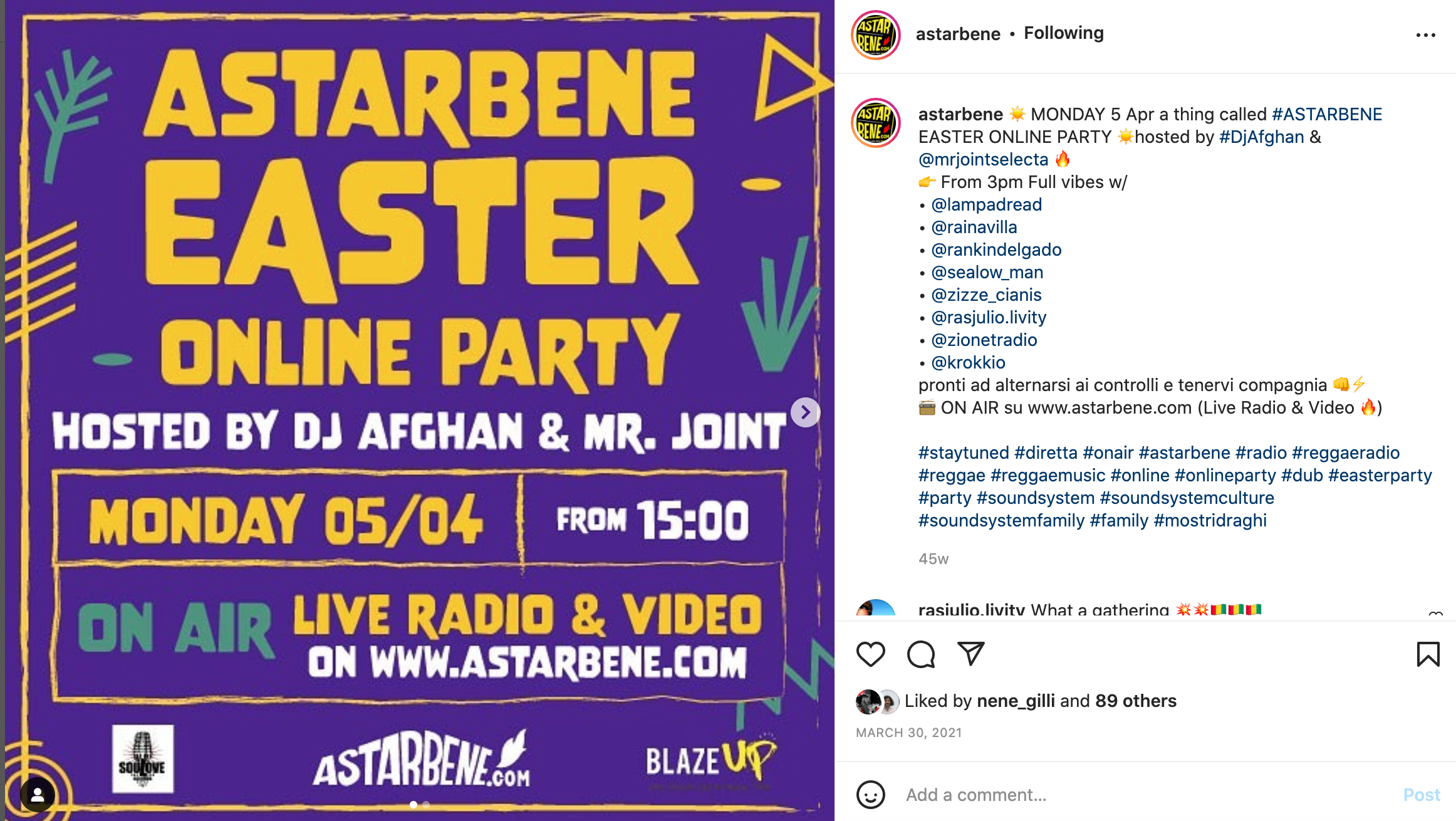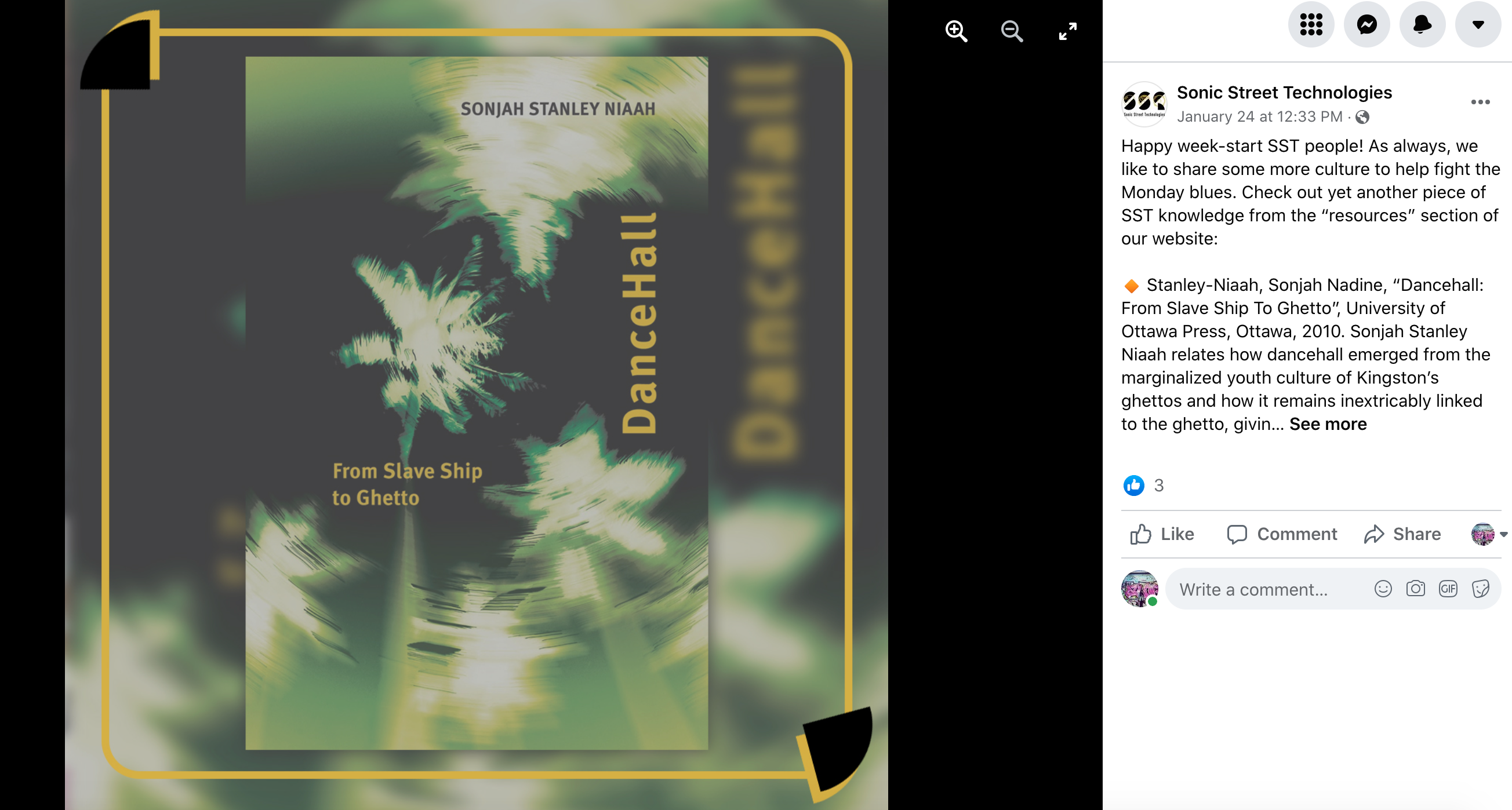Bringing Social Media to Sound System Life

Astarbene logo
Every research project is now expected to have a social media presence. Our project is no different. Attending to the intricacies of the global sound system cultures, social media platforms are even more essential to engaging with the communities that make up our artistic and intellectual spheres. We were fortunate to come across the work of Astarbene, a social media and reggae culture hub through our own networks of sound system aficionados in Italy. Previously, Astarbene worked with Sound System Outernational in 2019 when the conference took place in Naples (of which more later). Since then, we have continued our relationship with Astarbene through their ongoing work with the SST project for which they not only help us curate our social media feeds, but also give us potent insights into how sound system communities engage with performance-based and academic content, informed by their rich experience in the scene, both embodied and through online spaces.
In a previous blog on our ongoing social media ethnography of sound system cultures, I explored how a particular visual culture is under development through practitioner communities on platforms like Instagram. Our ongoing work with Astarbene is an asset to understanding sound system communities in other ways as well, in particular how audiences, practitioners and enthusiasts create cultural ecosystems that go beyond spatial and temporal bounds, especially in the aftermath of the COVID-19 pandemic. Since Astarbene, in the entirety of its mandate and activities, sits squarely between the multiple domains of practice and ways of being (i.e. audience vs. artist, scholarship vs. public outreach), as an organization, it is a rich site for investigation into the evolution of media practices that are undertaken within in the context of Italian reggae and sound systems cultures. Astarbene’s network of practice in the ongoing development of the cultural economy and visual cultures of sonic street technologies is worth further study.
Working with SST
When I joined the Sonic Street Technologies project at the start in January 2021, I was told that social media would be a major part of the project; not just as a basis of research dissemination, but also as a site of research itself. In the past, I held a variety of roles where social media management was a key part for academic outreach. However, this is the first time that social media was going to be part of the research itself. What’s more, when I learned about how Astarbene operate, I actually exclaimed during the team meeting, “I didn’t know that could be a thing!” This is not because of unfamiliarity with the professionalization and formalization of the role of social media managers that is widespread throughout industry, but that it was apparent that the very nature of the means by which Astarbene operated, social media was actually somehow secondary to both the community relationships and the cultivation of leisure and recreation that it was the site of. Social media management, was a means by which the community and its attended leisure interests, specifically in reggae and sound system culture could be sustained by those in the Astarbene collective. In short, there was something palpably organic, generative and nearly idyllic about Astarbene’s way of working that seemed particularly potent to me.
Pietro, who is part of a sound system, got involved in Astarbene when a friend of his asked him to host a show on Astarbene’s online radio. “That was one of the best days of my life”, he remarks. Two others in the collective who help run SST’s social media, Elena and Dina, are childhood friends. The Astarbene collective functions, thus, as a kinship group of kinds, where professional, interest-based and friendship networks coincide to form a multifaceted work/recreation environment that functions loosely and with flexibility of time.

The Astarbene collective
Before the Sonic Street Technologies project became formally funded by the European Research Council, our team and many associates gathered together each year to organize Sound System Outernational (SSO), a conference attended by scholars and practitioners alike who are interested in global sound system cultures. In its 2019 iteration, held in Naples, Italy, a key part of the conference, namely, the dissemination of content and social media outputs, had been conducted by Astarbene. At present, Astarbene is collaborator with the Sonic Street Technologies project through their involvement in our social media channels.
While social media is a key part of the information ecosystem in many people’s lives, Often, in the context of scholarly and research work, the role that social media may play may be seen as secondary to the core part of research activities themselves, but this trend has shifted in the last decade (Airoldi 2018; Gruzd, Staves, and Wilk 2012; Kapoor et al. 2018; Rowlands et al. 2011). While social media channels may become the means by which other researchers and stakeholders find their way into a project, social media managers are not often credited as producers of knowledge themselves, in the traditional sense.
Astarbene is a Rome-based media collective founded in 2015 that engages with the Italian reggae and sound systems culture scene through media production, with the aim of dismantling the perceived and tangible barriers between artists and audiences. Currently, while also running a social media business, Astarbene runs a radio program, a blog, a podcast, and routinely covers noteworthy events and festivals within Italy. Their work over the years has contributed to the development of an archive of audio-visual material on the associated music scenes.
Astarbene currently helps run the Sonic Street Technology project’s social media accounts, namely, Instagram and Facebook accounts, in an effort to bring more engagement from SST aficionados, practitioners and the general public. Astarbene has also produced social media analytics and a strategy for the Sonic Street Technologies project, which reflect a unique (and albeit, changing) demographic that engages with the content. Astarbene’s experience with both the online and in-person contexts of sound system cultures in Italy, as well as their growing interest and aptitude in popular and scholarly literature on sound system cultures makes them simultaneously a potent partner in the SST project, while they remain embedded as a participant in the scene itself.
Background:
Astarbene was founded in 2015. Its founders and members were formerly associated with the Rising Love, a nightclub in Rome, Italy, where they managed reggae events and handled public relations. In the year prior, during the summer of 2014, some members of what is now Astarbene came up with the name to describe the feelings they had during a road trip to Rototom Sunsplash, one of the largest reggae festivals in Europe that takes place yearly near Valencia, Spain. In Italian, the word “Astarbene” sounds like “to feel good”. To carry forward these affective spaces, in February 2015, Astarbene started with the airing of the first episode of “Astarbene: The Reggae Radio Show” on Radio Kaos Italy. Some members of Astarbene had a particular interest in the visual arts and began a project called “Reggae Reporters”, with the goal of covering festivals, sessions and events, and to portray them with photo reportages, videos and interviews what happened on and off stage, in order to better connect artists and their audiences. Among the festivals covered by the Reggae Reporters include Overjam Festival, Rototom Sunsplash, Bababoom Festival, Dub Stone, Reno Sunsplash, Amsterdam Weekender, Manuel Dub, and Romamuffin. In 2018, the radio show “Astarbene: The Reggae Radio Show” and the Reggae Reporters project merged into Astarbene.com, an actual container-website that offers a 24/7 radio programme and today has more than 20 original live shows made by several sound systems and crews from all over Italy. The Astarbene collective now counts more than 30 members, divided into smaller groups (media, DJs, speakers, photographers, etc.).
Astarbene as hybrid leisure site/workplace/community organization
Given the unique history of Astarbene as an internet-based cultural industry that had its roots in both the friendship/kinship networks of reggae aficionados in Rome and their embodied involvement in the nightclub scene, Astarbene is not a traditional workplace. Astarbene’s labour and production capacities are directly linked to local kinship networks – with some members of the collective being friends since childhood. Moreover, Astarbene’s work, in the form of media reportages, archives and radio station – are all built around the leisurely interests of its members. While in the pre-pandemic years, Astarbene had makeshift in-person work arrangements in Rome, due to the pandemic, as in-person work became unviable, Astarbene continued their work online, and even facilitated online versions of festivals and events that usually took place in person.
For instance, one of the biggest events that Astarbene has been covering for several years in the Bababoom Music Festival, which usually takes place in Marche, in Italy. However, due to the pandemic, in 2020, the festival was held entirely online. Astarbene shifted its strategies accordingly to provide support with more online content instead of the traditional audiovisual content that it would otherwise provide with its in person involvement in the festival. And throughout the pandemic conditions, Astarbene held various online parties to keep its communities of interest engaged.

Atarbene held a number of online parties during the pandemic
Similarly, while in 2019, when Sound System Outernational (SSO) took place in Naples, Italy, Astarbene was present in the scene and interacted with the conference goers and other enthusiasts to create audio-visual content that would later be used by SSO, and subsequently, as material for scholarly research, by SST. However, in 2021, since pandemic conditions once again meant that an in-person conference could not be held, Astarbene helped run SSO’s social media through Instagram and Facebook, with significant contributions to the interface by which attendees would interact with SSO.

Astarbene covering events for Sound System Outernational in Naples, Italy, in 2019
In their role and mandate to mediate the relationship between audiences and artists/practitioners in the context of sound system cultures, Astarbene curates the space through which such interactions can happen. This space of mediation, through their curatorial work on Instagram, Facebook and their radio station, is both a site of practice-based research, and leisure, for those who are undertaking it. This hybridity in Astarbene being both a site of leisure and entertainment, and a site for cultural and knowledge production, makes it similar to a rising trend under neoliberal conditions which are commonly termed “side hustles” – in that, what would usually be in the realm of hobbies for groups and individuals are turned into businesses that provide additional or the bulk of the income for those involved. In the case of Astarbene, the collective members use their knowledge of social media and music sharing platforms, archival collections of reggae and sound system culture artifacts and their own embodied understandings of content and knowledge of the scene as the basis for their business – which in turn also provides an invaluable source of expertise for the SST project.
Astarbene as a site for practice-based research
Practice-based research refers to the diverse methodologies and orientations to investigations in the social sciences, natural and applied sciences, and humanities, where the employment of an arts-based practice, such as audio-visual work, archiving, music, creative writing, and other forms of visual and performing arts are the means by which research is conducted. The aim of this kind of research is not necessarily to find answers to specific research questions, but to attune deeper into the questions themselves through a multiplicity of meditations and representations. It can be argued that Astarbene, through their work in intervening in and curating the spaces between audience and artists/practitioners, are doing the work of practice-based research. With their ongoing collaboration with SST, and other work in association with the reggae scene in Italy and beyond, they cultivate the ethos by which reggae and sound system culture at large is perceived, taken up by audiences and disseminated further. This practice of audio-visual-based social media interventions, are also associated with how the reggae/sound system scenes might evolve in response to audience engagement and feedback, both in real life and online. Although much of Astarbene’s work is currently online-based, it is beyond doubt that over the years, their in-person involvement in the scene has also had transformative effects, materially, artistically, and otherwise on the events, groups and individuals they have attended and represented.
Bringing Astarbene’s expertise into academic conversations

Astarbene creates Facebook content for SST, including showcasing scholarly research related to sound system cultures
While Astarbene manages Facebook and Instagram platforms for the Sonic Street Technologies project, I manage Twitter, which is often the site of more academic conversations. Initially, I used the tone and presentation style of other similarly-placed research projects to engage with and find new communities of interest on Twitter, but seeing the success of Astarbene’s management of our Facebook and Instagram feeds, I ventured to experiment with the content that Astarbene puts out, modified for Twitter. As it turns out, the level of engagement increased as I put forth more visual content, showcasing scholarly work and archival photos depicting reggae and sound system cultures through Twitter that was originally curated by Astarbene. Astarbene’s expertise thus not only works on the reggae scene, but is also a potent tool in increasing academic interest in the project. With this in mind, we will continue to closely follow their embodied and embedded expertise and learn more about how sound system cultures traverse the online-offline divides.
References
Anderson, Leon, and Mathew Austin. 2012. “Auto-Ethnography in Leisure Studies.” Leisure Studies 31 (2): 131–46.
Brown-Saracino, Japonica, Jessica Thurk, and Gary Alan Fine. 2008. “Beyond Groups: Seven Pillars of Peopled Ethnography in Organizations and Communities.” Qualitative Research 8 (5): 547–67.
Clerke, Teena, and Nick Hopwood. 2014. “Ethnography as Collective Research Endeavor.” In Doing Ethnography in Teams, 5–18. Springer.
Fine, Gary Alan. 2003. “Towards a Peopled Ethnography: Developing Theory from Group Life.” Ethnography 4 (1): 41–60.
Gans, Herbert J. 1999. “Participant Observation in the Era of ‘Ethnography.’” Journal of Contemporary Ethnography 28 (5): 540–48.
Gruzd, Anatoliy, Kathleen Staves, and Amanda Wilk. 2012. “Connected Scholars: Examining the Role of Social Media in Research Practices of Faculty Using the UTAUT Model.” Computers in Human Behavior 28 (6): 2340–50.
Rowlands, Ian, David Nicholas, Bill Russell, Nicholas Canty, and Anthony Watkinson. 2011. “Social Media Use in the Research Workflow.” Learned Publishing 24 (3): 183–95.
